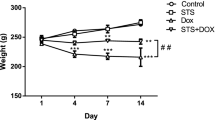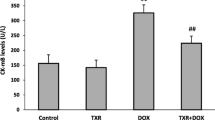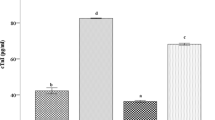Abstract
Doxorubicin (DOXR) is an important chemotherapeutic drug used in cancer treatment for many years. Several studies reported that the use of DOXR increased toxicity by causing an increase in oxidative stress (OS), especially in the heart. In this study, we investigated the protective effect of selenium (Se) and the role of transient receptor potential melastatin‐2 (TRPM2) channel activation by using N-(p-amylcinnamoyl) anthranilic acid (ACA) in a model of DOXR-induced cardiotoxicity. Sixty female rats were equally divided into the control, dimethyl sulfoxide (DMSO), DOXR, DOXR + Se, DOXR + ACA, and DOXR + Se + ACA groups. Glutathione (GSH), glutathione peroxidase (GSH-Px), caspases (Cas) 3 and 9, interleukin 1β (IL-1β), tumor necrosis factor-α (TNF-α), reactive oxygen species (ROS), poly [ADP-ribose] polymerase 1 (PARP-1), and TRPM2 channel levels were measured by ELISA. In addition, histopathological examination was performed in cardiac tissues and TNF-α, caspase 3, and TRPM2 channel expression levels were determined immunohistochemically. The levels of GSH, GSH-Px, caspases 3 and 9, IL-1β, TNF-α, ROS, PARP-1, and TRPM2 channel in serum, and cardiac tissue in the DOXR group were higher than in the control and DMSO groups (p < 0.05). However, these parameters in Se and/or ACA treatment groups were lower than in the DOXR group (p < 0.05). Also, we determined that Se and/or ACA treatment together with DOXR application decreased the TNF-α, Cas-3, and TRPM2 channel expression levels in the cardiac tissue. The data showed that administration of Se and/or ACA treatment together with DOXR may be used as a therapeutic agent in preventing DOXR-induced cardiotoxicity.





Similar content being viewed by others
Data Availability
The data that support the findings of this study are available from the corresponding author upon request.
Change history
11 March 2023
A Correction to this paper has been published: https://doi.org/10.1007/s12011-023-03622-2
References
Koleini N, Kardami E (2017) Autophagy and mitophagy in the context of doxorubicin-induced cardiotoxicity. Oncotarget 8(28):46663–46680
Kim Y, Ma AG, Kitta K et al (2003) Anthracycline-induced suppression of GATA-4 transcription factor: implication in the regulation of cardiac myocyte apoptosis. Mol Pharmacol 63(2):368–377
Saleh Ahmed AS (2022) Potential protective effect of catechin on doxorubicin-induced cardiotoxicity in adult male albino rats. Toxicol Mech Methods 32(2):97–105
De Beer EL, Bottone AE, Voest EE (2001) Doxorubicin and mechanical performance of cardiac trabeculae after acute and chronic treatment: a review. Eur J Pharmacol 415(1):1–11
Hale JP, Lewis IJ (1994) Anthracyclines: cardiotoxicity and its prevention. Arch Dis Child 71(5):457–462
Wang S, Zhao X, Liu Q et al (2022) Selenoprotein K protects skeletal muscle from damage and is required for satellite cells-mediated myogenic differentiation. Redox Biol 50:102255
Gong T, Hashimoto AC, Sasuclark AR et al (2021) Selenoprotein M promotes hypothalamic leptin signaling and thioredoxin antioxidant activity. Antioxid Redox Signal 35(10):775–787
Steinbrenner H, Speckmann B, Klotz L-O (2016) Selenoproteins: antioxidant selenoenzymes and beyond. Arch Biochem Biophys 595:113–119
Meuillet E, Stratton S, Prasad Cherukuri D et al (2004) Chemoprevention of prostate cancer with selenium: an update on current clinical trials and preclinical findings. J Cell Biochem 91(3):443–458
Van Vleet JF, Ferrans VJ (1980) Clinical and pathologic features of chronic adriamycin toxicosis in rabbits. Am J Vet Res 41(9):1462–1469
Fischer JG, Tackett RL, Howerth EW et al (1992) Copper and selenium deficiencies do not enhance the cardiotoxicity in rats due to chronic doxorubicin treatment. J Nutr 122(11):2128–2137
Doroshow JH, Locker GY, Myers CE (1980) Enzymatic defenses of the mouse heart against reactive oxygen metabolites: alterations produced by doxorubicin. J Clin Invest 65(1):128–135
Naziroglu M (2007) New molecular mechanisms on the activation of TRPM2 channels by oxidative stress and ADP-ribose. Neurochem Res 32(11):1990–2001
Naziroglu M, Oz A, Yildizhan K (2020) Selenium and neurological diseases: focus on peripheral pain and TRP channels. Curr Neuropharmacol 18(6):501–517
Çelik Ö, Nazıroğlu M (2012) Melatonin modulates apoptosis and TRPM2 channels in transfected cells activated by oxidative stress. Physiol Behav 107(3):458–465
Naziroglu M, Luckhoff A (2008) A calcium influx pathway regulated separately by oxidative stress and ADP-Ribose in TRPM2 channels: single channel events. Neurochem Res 33(7):1256–1262
Hara Y, Wakamori M, Ishii M et al (2002) LTRPC2 Ca2+-permeable channel activated by changes in redox status confers susceptibility to cell death. Mol Cell 9(1):163–173
Akyuva Y, Naziroglu M, Yildizhan K (2020) Selenium prevents interferon-gamma induced activation of TRPM2 channel and inhibits inflammation, mitochondrial oxidative stress, and apoptosis in microglia. Metab Brain Dis 36(2):285–298
Yuksel E, Naziroglu M, Sahin M et al (2017) Involvement of TRPM2 and TRPV1 channels on hyperalgesia, apoptosis and oxidative stress in rat fibromyalgia model: Protective role of selenium. Sci Rep 7(1):17543
Naziroglu M, Oz A, Yildizhan K (2020) Selenium and neurological diseases: focus on peripheral pain and TRP channels. Curr Neuropharmacol 18(6):501–517
Naziroglu M, Ozgul C, Kucukayaz M et al (2013) Selenium modulates oxidative stress-induced TRPM2 cation channel currents in transfected Chinese hamster ovary cells. Basic Clin Pharmacol Toxicol 112(2):96–102
Hassan MQ, Akhtar MS, Afzal O et al (2020) Edaravone and benidipine protect myocardial damage by regulating mitochondrial stress, apoptosis signalling and cardiac biomarkers against doxorubicin-induced cardiotoxicity. Clin Exp Hypertens 42(5):381–392
Cengiz O, Baran M, Balcioglu E et al (2021) Use of selenium to ameliorate doxorubicin induced hepatotoxicity by targeting pro-inflammatory cytokines. Biotech Histochem 96(1):67–75
Cakir M, Duzova H, Tekin S et al (2017) ACA, an inhibitor phospholipases A2 and transient receptor potential melastatin-2 channels, attenuates okadaic acid induced neurodegeneration in rats. Life Sci 176:10–20
Bradford MM (1976) A rapid and sensitive method for the quantitation of microgram quantities of protein utilizing the principle of protein-dye binding. Anal Biochem 72(1–2):248–254
Beydemir S, Ciftci M, Küfrevioglu ÖI et al (2002) Effects of gentamicin sulfate on enzyme activities of carbonic anhydrase from human erythrocytes in vitro and from rat erythrocytes in vivo. Biol Pharm Bull 25(8):966–969
Ishibashi H, Suzuki T, Suzuki S et al (2003) Sex steroid hormone receptors in human thymoma. J Clin Endocrinol Metab 88(5):2309–2317
Parra ER, Villalobos P, Mino B et al (2018) Comparison of different antibody clones for immunohistochemistry detection of programmed cell death ligand 1 (PD-L1) on non–small cell lung carcinoma. Appl Immunohistochem Mol Morphol 26(2):83
Sheibani M, Azizi Y, Shayan M et al (2022) Doxorubicin-induced cardiotoxicity: an overview on pre-clinical therapeutic approaches. Cardiovasc Toxicol 22(4):292–310
Hekmat AS, Navabi Z, Alipanah H et al (2021) Alamandine significantly reduces doxorubicin-induced cardiotoxicity in rats. Hum Exp Toxicol 40(10):1781–1795
Deng J, Huang M, Wu H (2021) Protective effect of limonin against doxorubicin-induced cardiotoxicity via activating nuclear factor - like 2 and Sirtuin 2 signaling pathways. Bioengineered 12(1):7975–7984
Ekinci Akdemir FN, Yildirim S, Kandemir FM et al (2021) Protective effects of gallic acid on doxorubicin-induced cardiotoxicity; an experimantal study. Arch Physiol Biochem 127(3):258–265
Arunachalam S, Nagoor Meeran M, Azimullah S et al (2021) Nerolidol attenuates oxidative stress, inflammation, and apoptosis by modulating Nrf2/MAPK signaling pathways in doxorubicin-induced acute cardiotoxicity in rats. Antioxidants 10(6):984
Arunachalam S, Nagoor Meeran MF, Azimullah S et al (2021) Nerolidol attenuates oxidative stress, inflammation, and apoptosis by modulating Nrf2/MAPK signaling pathways in doxorubicin-induced acute cardiotoxicity in rats. Antioxidants (Basel) 10(6):984
Yang HB, Lu ZY, Yuan W et al (2021) Selenium attenuates doxorubicin-induced cardiotoxicity through Nrf2-NLRP3 pathway. Biol Trace Elem Res 200(6):2848–2856
Aydin S, Eren MN, Kuloglu T et al (2015) Alteration of serum and cardiac tissue adropin, copeptin, irisin and TRPM2 expressions in DOX treated male rats. Biotech Histochem 90(3):197–205
Abdel-Daim MM, Khalifa HA, Ahmed AA (2017) Allicin ameliorates doxorubicin-induced cardiotoxicity in rats via suppression of oxidative stress, inflammation and apoptosis. Cancer Chemother Pharmacol 80(4):745–753
Songbo M, Lang H, Xinyong C et al (2019) Oxidative stress injury in doxorubicin-induced cardiotoxicity. Toxicol Lett 307:41–48
Yildizhan K, Çinar R, Naziroğlu M (2022) The involvement of TRPM2 on the MPP+-induced oxidative neurotoxicity and apoptosis in hippocampal neurons from neonatal mice: protective role of resveratrol. Neurol Res 44(7):636–644
Yıldızhan K, Nazıroğlu M (2021) Protective role of selenium on MPP+ and homocysteine-induced TRPM2 channel activation in SH-SY5Y cells. J Recept Signal Transduct 1–10
Aboutaleb N, Shamsaei N, Khaksari M et al (2015) Pre-ischemic exercise reduces apoptosis in hippocampal CA3 cells after cerebral ischemia by modulation of the Bax/Bcl-2 proteins ratio and prevention of caspase-3 activation. J Physiol Sci 65(5):435–443
Daldal H, Nazıroğlu M (2022) Selenium and resveratrol attenuated diabetes mellitus-mediated oxidative retinopathy and apoptosis via the modulation of TRPM2 activity in mice. Biol Trace Elem Res 200(5):2283–2297
Zhang X, Jiang Y, Xie Y et al (2021) Inhibition of gastric cancer cell apoptosis by long noncoding RNA TRPM2-AS via mitogen-activated protein kinase and activators of transduction-3. J Gastroenterol Hepatol 36(1):186–195
Acknowledgements
This study was supported by Van Yuzuncu Yil University Scientific Research Projects (BAP) Coordinatorship with project numbered TYD-2021-9714.
Author information
Authors and Affiliations
Contributions
Study design: K.Y. Data collection: all authors. Statistical analysis: K.Y., Z.H., and F.A. Data interpretation: Z.H., K.Y., and F.A. Manuscript preparation: K.Y. and Z.H. Literature search: Z.H., K.Y., and F.A. All authors reviewed the manuscript.
Corresponding author
Ethics declarations
Conflict of Interest
The authors declare no competing interests.
Additional information
Publisher's Note
Springer Nature remains neutral with regard to jurisdictional claims in published maps and institutional affiliations.
The original online version of this article was revised: Under the heading "Biochemical Measurement in Cardiac Homogenates and Serum" in the first line is should read "The levels of TRPM2 (MyBioSource, Cat#MBS9395911)".
Rights and permissions
Springer Nature or its licensor (e.g. a society or other partner) holds exclusive rights to this article under a publishing agreement with the author(s) or other rightsholder(s); author self-archiving of the accepted manuscript version of this article is solely governed by the terms of such publishing agreement and applicable law.
About this article
Cite this article
Yıldızhan, K., Huyut, Z. & Altındağ, F. Involvement of TRPM2 Channel on Doxorubicin-Induced Experimental Cardiotoxicity Model: Protective Role of Selenium. Biol Trace Elem Res 201, 2458–2469 (2023). https://doi.org/10.1007/s12011-022-03377-2
Received:
Accepted:
Published:
Issue Date:
DOI: https://doi.org/10.1007/s12011-022-03377-2




